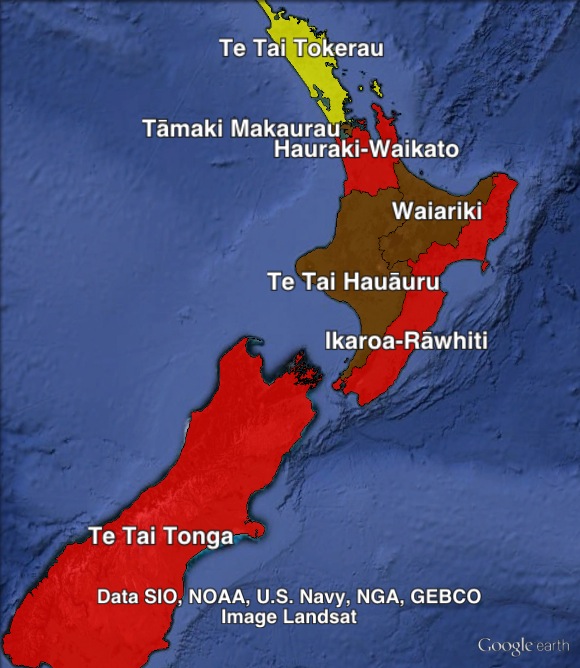| Electorate | Margin | Electorate | Margin |
| Hauraki-Waikato | LAB 35.53% vs MANA | Te Tai Tokerau | MANA 6.21% vs LAB |
| Ikaroa-Rāwhiti | LAB 37.61% vs MAORI | Te Tai Tonga | LAB 8.83% vs MAORI |
| Tāmaki Makaurau | MAORI 5.31% vs LAB | Waiariki | MAORI 10.59% vs MANA |
| Te Tai Hauāuru | MAORI 18.45% vs LAB |
There are seven Māori electorates covering the entirety of New Zealand. Three of these seats are held by the Labour Party, three are held by the Māori Party and one is held by the Mana Party.
Two of Labour’s three seats are very safe: Ikaroa-Rāwhiti along the east coast of the North Island, and Hauraki-Waikato immediately to the south of Auckland.
The Labour seat of Te Tai Tonga is more marginal, with an 8.8% margin against the Māori Party. Te Tai Tonga covers Wellington and the entire South Island, and was held by the Māori Party from 2008 to 2011.
The Māori Party’s safest seat is Te Tai Hauāuru, stretching from north of Wellington to just south of Hamilton and covering much of the west coast of the North Island. The seat has been held by Tariana Turia since she was a member of the Labour Party, but she will be retiring in 2014 and it’s not clear how much of the Māori Party vote is a personal vote for her.
The Māori Party also holds Waiariki on the Bay of Plenty, which is held by the party’s new co-leader Te Ururoa Flavell. He should be able to hold on with a 10.6% margin against the Mana Party.
The Māori Party also holds Tāmaki Makaurau, which covers most of the Auckland urban area. That seat is only held by a 5.3% margin, and with former co-leader Pita Sharples retiring, it could be in danger.
Hone Harawira has held Te Tai Tokerau since 2005, first as a member of the Māori Party, and then as leader of the Mana Party since 2011. Te Tai Tokerau covers Northland and the northwestern rural fringe of Auckland. The Mana Party has now formed an alliance with the Internet Party, and both parties will be relying on a victory in Te Tai Tokerau to qualify for list seats.
Redistribution
No changes were made to five out of the seven Māori electorates. A small area was transferred from Ikaroa-Rāwhiti to Wairaki, with no measurable impact on the results in those areas.
Assessment
These seven electorates are some of the most important individual races in the country. The Māori Party does not poll high enough to win list seats, so relies entirely on winning electorates for representation in Parliament. With an open seat in Tāmaki Makaurau, the party is in serious danger of dropping to two seats. The Mana Party, and its allies in the Internet Party, rely on winning Te Tai Tokerau for representation in Parliament.
The overall political make-up of the Māori electorate is very distinct from the rest of the country. Labour performs slightly above-average, and the Green Party performs slightly below-average. New Zealand First performs very well on the party vote. The Māori and Mana parties rely almost entirely on these electorates for their party votes, and rely on winning seats in these areas to stay in Parliament. The National Party barely registers in the area.
On the electorate vote, Labour leads with 40.7%, followed by the Māori Party on 31.5% and Mana on 21.2%. The Green Party polled just under 5%. Neither the Māori Party or the Mana Party polled over 1% in any of the other six regions.
On the party vote, Labour polled about the same, but both the Māori and Mana parties polled less than on the electorate vote. The Green Party did quite well, with 10.3%. The gap between the second-placed party (Māori Party) and the sixth-placed party (National) is only 7%.
National and New Zealand First do not run in Māori electorates. The National Party polled less than a fifth of the party vote in the Māori electorates as they did nationwide. New Zealand First, on the other hand, polled quite well on the party vote in the Māori electorates – 9.5% in the Māori seats as opposed to 6.6% nationally. This is better than any of the other six geographic regions I have profiled. This likely reflects New Zealand First’s history as a party that competed in the Māori electorates, winning one seat in 1993 and all five seats in 1996.
2011 election results
| Electorate Votes | Party Votes | |||||
| Party | Votes | % | Swing | Votes | % | Swing |
| Labour | 49,802 | 40.69 | +3.15 | 52,925 | 40.96 | -9.14 |
| Māori | 38,545 | 31.49 | -26.37 | 20,172 | 15.61 | -13.28 |
| Mana | 25,889 | 21.15 | +21.15 | 16,823 | 13.02 | +13.02 |
| Green | 6,044 | 4.94 | +1.87 | 13,341 | 10.33 | +6.41 |
| New Zealand First | 12,219 | 9.46 | +3.35 | |||
| National | 11,085 | 8.58 | +1.13 | |||
| Legalise Cannabis | 1,262 | 1.03 | +0.44 | 1,577 | 1.22 | +0.13 |
| Conservative | 589 | 0.46 | +0.46 | |||
| ACT New Zealand | 230 | 0.18 | -0.30 | |||
| United Future | 164 | 0.13 | -0.01 | |||
| Libertarianz | 34 | 0.03 | +0.01 | |||
| Democrats | 29 | 0.02 | +0.01 | |||
| Alliance | 21 | 0.02 | -0.01 | |||
| Others | 866 | 0.71 | +0.28 | |||



